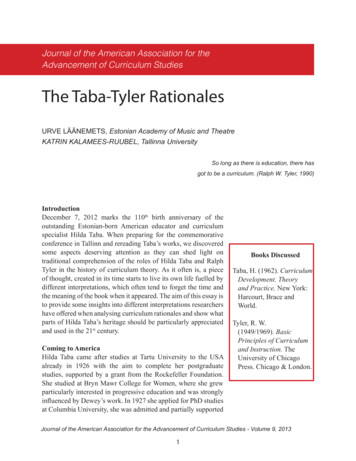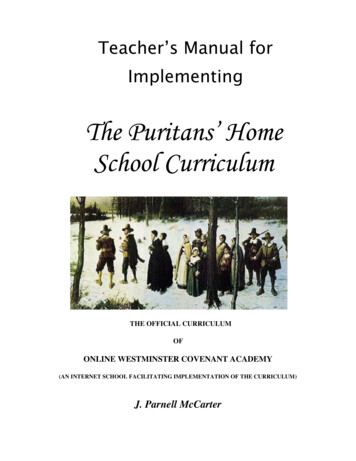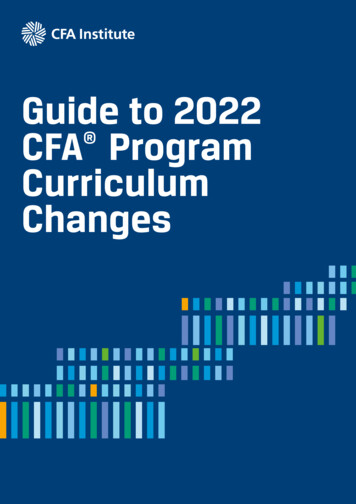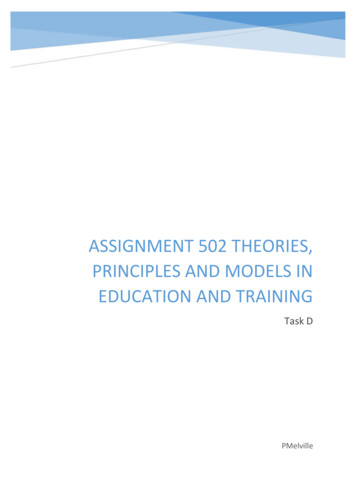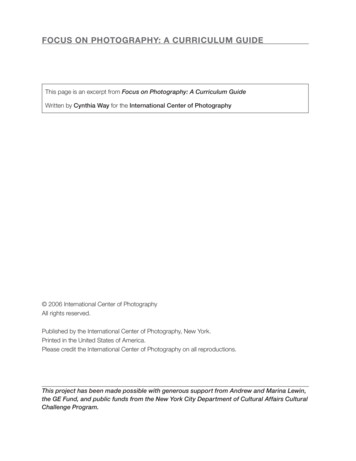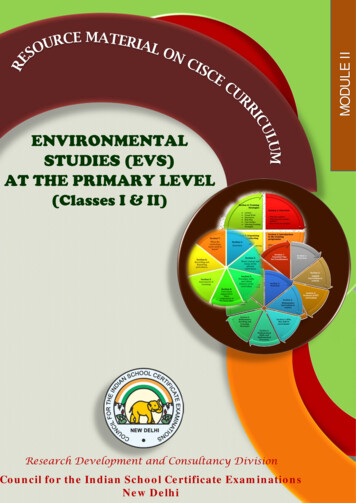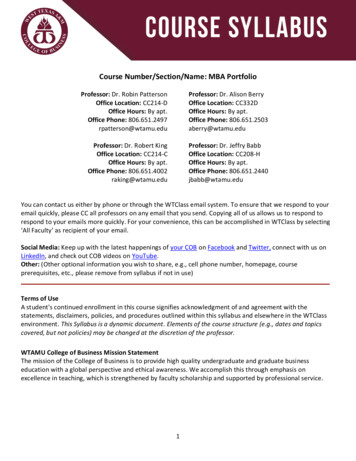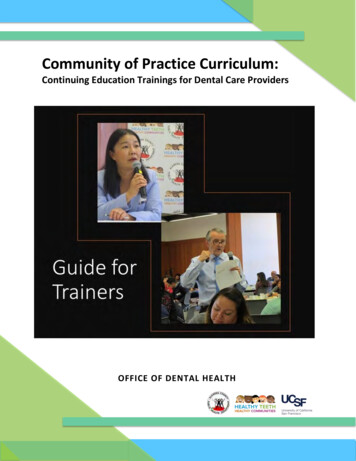
Transcription
Community of Practice Curriculum:Continuing Education Trainings for Dental Care ProvidersOFFICE OF DENTAL HEALTHAlameda County Public Health Department – Office of Dental Health
Intentionally kept blankOffice of Dental Health/ACPHDPage 2 of 69
Table of ContentsAcknowledgementsp.4Executive Summaryp.5Introduction: Need to increase access to & utilization of dental careBackgroundAlameda County’s DTI ModelDentist Network: Community of Practice (COP)The CE CurriculumCE Training Planp.7Modules for CE coursesModule 1: Introduction to dental public health, dental care coordination,role of dentist network, project overviewModule 2: Behavioral guidance: helping children accept dental careModule 3: Motivational interviewingModule 4: The science and practice of early childhood oral health careModule 5: Science of caries progression & caries management strategies, anddiagnosis/treatment planning: CAMBRA principlesModule 6: Interim caries management and common pediatric dentalrestorative techniquesModule 7: Practice more efficiently with more profitability:stainless steel crowns, space maintainersModule 8: Pediatric anesthetic and behavior management techniques:expanding your comfort zone to include younger patientsModule 9: Oral health care for special needs children and pregnant womenModule 10: Tobacco, vaping, and oral health: an action guide for dental professionalsAppendixGlossaryModule 3: Family Oral Health Education (FOHE) definitionsSatisfaction/Evaluation SurveyDental Public HealthOffice of Dental 56p.60p.61p.63p 66Page 3 of 69
AcknowledgementsThis guide for trainers was developed for the Healthy Teeth Healthy Communities (HTHC) projectof the Office of Dental Health (ODH) of Alameda County Public Health Department (ACPHD).HTHC is a project of the Dental Transformation Initiative (DTI), funded by the CaliforniaDepartment of Health Care Services (DHCS) as a Local Dental Pilot Program (LDPP). HTHC wasimplemented from April 2017 to December 2020.A curriculum was created and offered during the HTHC project period to the Alameda Countydental health care providers. The primary target audience for this curriculum was comprised ofdentists but due to high demand Registered Dental Hygienists (RDH), Registered Dental Assistants(RDA), and Dental Assistants (DA) also participated in the trainings.The original curriculum was conceptualized and developed in 2017 by ODH in collaboration withthe Pediatric Dentistry Division of the University of California San Francisco (UCSF) School ofDentistry. The ODH team members were Dr. Bahar Amanzadeh, Tracey Andrews, and consultantDr. Jared Fine; and the UCSF team members were Prof. Ray Stewart, Assoc. Prof. Ling Zhan, andAssist. Prof. Kristin Hoeft. The Continuing Education (CE) trainings/courses for the curriculum weremostly conducted by UCSF faculty Prof. Ray Stewart and Assoc. Prof. Ling Zhan.Based on the lessons learned this guide for trainers was written in 2020 by the ODH teammembers Dr. Quamrun Eldridge, Dr. Suhaila Khan, Dr. Bhavana Ravi, Dr. Deanna Aronoff, JamalYousuf, and consultant Dr. Jared Fine.This guide for trainers was designed and formatted by Kerri Chen.Office of Dental Health/ACPHDPage 4 of 69
Executive SummaryAlameda County Office of Dental Health (ODH) was one of the recipients of the Local Dental PilotProgram (LDPP) which was administered under the Dental Transformation Initiative (DTI) of theMedi-Cal 1115 waiver. Alameda County’s DTI model was called the Healthy Teeth HealthyCommunities (HTHC) project. Through a county-wide collaboration it increased access to andutilization of dental care for children and youth ages 0-20 years during the project period (2017 to2020). The model incorporated dental public health principles and addressed the barriers thatcontribute to low access and utilization of dental care. The HTHC model also addressed thenecessary interactions of clients, providers, and databases through a system of care that facilitatedthe mediation and connections which increased access to and utilization of dental care for MediCal children in Alameda County.One of the three strategies of HTHC was to create a dentist network (addressed provider factors).This network of dentists was called the Community of Practice (COP), who served children andyouth ages 0-20 years. This network included 164 dentists (133 from 8 Federally Qualified HealthCenters; 2 from 1 community health center; and 29 from 23 private dental offices).The vision for COP was to build a sufficient network of dentists who are sensitive to equitableaccess to care, knowledgeable of barriers to care experienced by Medi-Cal enrollees, andinterested in Dental Public Health i.e. preventive dentistry.To achieve this vision, a curriculum was developed for the COP members. This curriculum includedforming a learning community, Continuing Education (CE) courses, and a mentorship program.During the project period 14 CE courses (49 CE units) were provided. On average each CE coursewas attended by 60-80 participants. There were 17 pediatric dentistry mentors to support themembers of the COP. The CE courses also focused on building confidence and skills of generaldental providers to offer dental care services to children, especially young children ages 0-5 years.This guide for trainers was written based on the lessons learnt from the COP curriculum. Thisinteractive guide consists of 10 CE courses/modules (35 CE units). Dental Public Health is includedin Module 1; it can be offered as a single module also. Although the other modules focus onclinical skills, Dental Public Health is integrated throughout the modules. The topics includebehavioral guidance, motivational interviewing, early childhood oral health care, CAMBRAprinciples, interim caries management and common pediatric dental restorative techniques,stainless steel crowns, space maintainers, pediatric anesthetic and behavior managementtechniques, oral health care for special needs children and pregnant women, and tobacco-vaping.This curriculum is a guide for trainers and can be used by any organization or institution whowants to provide CEs to dental providers, or build the capacity of dental providers to serve dentalpatients of different ages. These organizations may be County, State, dental societies, etc.Although this curriculum was developed for general dentists, it can be used for other dental careOffice of Dental Health/ACPHDPage 5 of 69
providers (e.g. RDH, RDA). This Community of Practice (COP) model and the curriculum can bebeneficial for the State-wide dental community.Office of Dental Health/ACPHDPage 6 of 69
Introduction:Need to Increase Access to and Utilization of Dental CareBackgroundCalifornia’s Dental Medicaid (i.e. Medi-Cal) program had a low utilization rate for children ( 50%)according to a State Auditor’s report in 2014. Barriers causing this low utilization were related to:patients, providers, and systems. These barriers were described by the Little Hoover CommissionReport in 2016. These reports led to an investment from the California Department of Health CareServices (DHCS) via the 1115 Medicaid waiver called the Dental Transformation Initiative (DTI) in2017. DTI invested in pilot projects in several counties to improve the dental health for Medi-Calchildren by focusing on “high-value care, improved access, and utilization of performancemeasures to drive service delivery system reform in the hope to increase the use of preventivedental services for children, prevent and treat more early childhood caries, and increase continuityof care for children” (accessed from DHCS website).Alameda County was one of the DTI funding recipients. This funding enabled Alameda CountyOffice of Dental Health (ODH) to conduct a county-wide intervention using a systems approach toaddress the barriers that contribute to low utilization of Medi-Cal Dental program services forchildren and youth ages 0-20 years.Alameda County’s DTI is called the Healthy Teeth Healthy Communities (HTHC). The HTHC projectis a cross-sector collaborative initiative to implement a county-wide dental health carecoordination system to ensure Medi-Cal eligible children receive prevention and continuity of careservices necessary to promote and maintain their dental health. HTHC aims to improve access todental care, increase the utilization of preventive dental services, increase continuity of care forchildren, and thus reduce the incidence of early childhood caries. This project incorporated twodental public health principles into its strategies:1. focus on improving oral health care for the population instead of the individual patient;and2. focus on preventive oral health care rather than treatment.Office of Dental Health/ACPHDPage 7 of 69
Alameda County’s DTI Model: Healthy Teeth Healthy Communities (HTHC)The Healthy Teeth Healthy Communities (HTHC) project used three strategies to address thebarriers in utilization:1) created a dental care coordination workforce (addressed client factors),2) created a dentist network (addressed provider factors), and3) created an online, cloud-based, HIPAA compliant data collection database (addressedsystems factors).This model reflects the necessary interactions of clients, providers, and databases through asystem of care that facilitated the mediation and connections which increased access to andutilization of dental care for Medi-Cal children in Alameda County.Figure 1. The HTHC ModelDentist Network: Community of Practice (COP)The 2nd strategy of the HTHC model was to create a network of dentists, called the Community ofPractice (COP), who served children and youth ages 0-20 years in Alameda County. This networkincluded 164 dentists (133 from 8 Federally Qualified Health Centers, 2 from 1 community healthcenter; and 29 from 23 private dental offices. On average each CE course was attended by 60-80participants, of whom about 50 were dentists and the rest were RDHs, RDAs, or DAs. The membersof this dentist network recognized the importance of equitable access to care and the barriers toadequate services often experienced by Medi-Cal enrollees. This network was also created toaddress the low provider participation in the Medi-Cal Dental Program and build the skills ofdental providers to offer dental care services to young children (ages 0-5 years).Office of Dental Health/ACPHDPage 8 of 69
Vision of the COPTo build a sufficient network of dentists who are sensitive to equitable access to care,knowledgeable of barriers to care experienced by Medi-Cal enrollees, proficient in the applicationof preventive dentistry, motivational interviewing and in interfacing with local and state paymentand monitoring systems. The vision will be achieved by:1. Identifying barriers, find solutions and support for dentists who wish to expand capacityto serve the target population.2. Supporting dentists in connecting with peers in the community who are serving thetarget population by creating formal avenues for sharing experiences and learningtogether.3. Engaging and motivate more dentists to better serve children from low income familiesin our community.4. Offering training and education to help increase dentists clinical and culturalcompetency to serve the target population.5. Identifying the usefulness of the dental care coordination model to increase access toand utilization of care by underserved population.6. Develop a shared sense of responsibility for the dental health of our communities.In order to build the capacity of this dentist network, the following actions were taken: Developed a curriculum which had 2 parts: Continuing Education (CE) courses and aMentorship program. Developed Continuing Education (CE) courses that reflect Dental Public Health andPediatric Dentistry topics. Developed mentorship program for general dentists to get support from pediatricdentists and other dental specialists. The mentors provided guidance to the generaldentists and/or served as referrals for children requiring specialty care. Built public-private partnerships between FQHCs and private dental offices. Promoted the importance and benefit of dental care coordination (in order to increaseutilization of services). Developed and facilitated the partnership between dental offices and communitydental care coordinators (CDCC); this connected strategy 1 and strategy 2 of the HTHCmodel. Emphasized providing oral health education to families with children, and Family OralHealth Education (FOHE) for families with children ages 0-5 years.The original curriculum was conceptualized and developed in 2017 by ODH in collaboration withthe Pediatric Dentistry Division of the University of California San Francisco (UCSF) School ofDentistry. The primary target audience for this curriculum was comprised of dentists but due tohigh demand Registered Dental Hygienists (RDH), Registered Dental Assistants (RDA), and DentalAssistants (DA) also participated in the trainings.Office of Dental Health/ACPHDPage 9 of 69
The CE CurriculumPurpose1. To increase the knowledge and understanding of dental care providers, especiallydentists, about Dental Public Health.2. To increase the capacity, confidence, and competence of the dental care providers,especially dentists, to care for children ages 0-20 years old.3. To provide CE units to the dental providers, especially the dentists.4. To connect dental providers/dental offices with CDCCs.OverviewThis curriculum/training guideline can be used by any organization or institution who wants toprovide CEs to dental providers, or build the capacity of dental providers to serve dental patientsages 0-20 years. These organizations may be County, State, dental societies, etc. Although thiscurriculum was developed for general dentists, it can be used for other dental care providers (e.g.RDH, RDA).Some characteristics of the curriculum were: These are no-cost CE courses for members of the COP dentist network. This curriculum is designed to support the general dental providers, especially general dentistswith useful skills that enhanced their confidence and competence in caring for children andyouth ages 0-20 years. It also focuses on developing the general dentist’s confidence and willingness to see veryyoung children (ages 0–5 years) because preventive dental care is crucial in achieving longterm positive outcomes in oral health. The training sessions include mostly in-person sessions, 1 hands-on practice at a simulationlaboratory at UCSF, and 3 online virtual sessions (due to COVID-19). This interactive curriculum covers the topics that will boost the knowledge, confidence andclinical skills of participants to identify the susceptible population, recognize the diseaseindicators, provide a suitable preventive and management plan, early disease recognition andmanagement, proficiency in the application of preventive dentistry, motivational interviewing,as well as to be able to interface with local and state payment and monitoring systems. The CE courses consist of 14 modules (49 CE units). The CE units were offered in 45 traininghours. Some CE training sessions were videotaped for use in future trainings. A few topics arerepeated in multiple modules due to the extra importance of the topic (e.g. local anesthesia,when to refer, taking care of younger patients). This guide for trainers provide content for 10courses/modules (35 CE units).Office of Dental Health/ACPHDPage 10 of 69
The following table shows the modules, topics, CE units, and the duration of the CE sessions forthis guide for trainers.CE Modules and TopicsCETrainingUnits Duration (hour)Module 1:Introduction to dental public health, dental care coordination, dentistnetwork, & project overviewModule 2:Behavior guidance: helping children accept dental careModule 3:Motivational interviewingModule 4:The science & practice of early childhood oral health careModule 5:Science of caries progression & caries management strategies, andtreatment planning: CAMBRA principlesModule 6:Interim caries management & common pediatric dental restorativetechniquesModule 7:Practice more efficiently with more profitability: stainless steel crowns,space maintainersModule 8:Pediatric anesthetic & behavior management techniques: expanding yourcomfort zone to include younger patientsModule 9:Oral health care for special needs children & pregnant womenModule 10:Tobacco, vaping, & oral health: action guide for dental 47CE Training PlanDuration of Training:3-4 hours includes registration time, course satisfaction survey/evaluation time, and breaktime.Location of Training Facility:Needed: yesTraining Team:Needed: yesOffice of Dental Health/ACPHDPage 11 of 69
The training team should consist of a facilitator, a trainer/s, a notetaker/timekeeper, andan administrative staff for each module. The facilitator and trainer should be differentpersons so the trainer can focus on the training content.Responsibilities of the Training Team: Facilitator: The facilitator will assure that the overall training runs smoothly including thelogistics. For group discussion multiple facilitators and notetakers need to be considered.The facilitator needs to arrive at least 1 hour before the start of the training session. Notetaker/timekeeper: The notetaker is needed to capture the discussions that take placeand the questions that come from the participants. Notetaker will also be the timekeeper. Administrative staff: The training team should also consist of administrative staff who willbe responsible for all the logistics. Trainer: will be responsible for all training content and handouts. The trainer needs toarrive at least half an hour before the start of the training session.Registration of Training Participants:Needed: yesRegistration at least 7 days before the day of the training.Sign-in at the beginning of each training day (for County recording and receiving CE).Format/Method of Learning: Interactive Lecture Discussion Q&A Activity – individual & group (breakout sessions) to§ solve problems§ build relationships (FQHC and private dentists) Practice case scenarios/case study Role play Brainstorming Simulation laboratoryMaterials:Video: optional information included throughout the curriculumPowerPoint presentation: neededHandouts: optionalSatisfaction/evaluation survey: neededLaptop: neededProjector: neededPens, markers, writing pads, post its: neededFlip charts: neededSetting: dinner table (tables with chairs for seating of group of 6-8 participants perOffice of Dental Health/ACPHDPage 12 of 69
table). This setting allows for better conversations, networking, and practicing casescenarios.Dental tools & materials: may be needed (if applicable for module)Office of Dental Health/ACPHDPage 13 of 69
Module 1Introduction to Dental Public Health, Dentist Network,Dental Care Coordination, & Project OverviewSession: 3 hoursCE: 2 hoursSESSION OVERVIEWThis module will set the context for oral health disparities and the need to increase access todental care. This module will discuss why there is low utilization of dental services by children andyouth aged 0-20 years and what can be done to improve this low utilization. This module will alsoillustrate the unique partnership among the dentist network and private-public organizations. Thegoal today is to spark a commitment from each participant to work towards improving the dentalhealth of children in Alameda County.LEARNING OBJECTIVESAt the end of this module, participants will be able to:1. Describe the importance of dental public health, and health and oral health inequalities(barriers to access).2. Describe the need to increase preventive services and utilization of the Medi-Cal DentalProgram for children 0-20 years.3. Provide an overview of the project and dental care coordination (how access to care can beimproved through dental care coordination/patient navigation and partnership).4. Describe the roles of the dentists and dentist network.5. Describe the Medi-Cal Dental Program.MATERIALSVideoPowerPoint presentationHandoutsSatisfaction/Evaluation surveyLaptopProjectorPens, markers, writing pads, post itsFlip chartsSettingOffice of Dental Health/ACPHDNot dNeededDinner TablePage 14 of 69
METHODWelcome, Icebreaker, and Table Networking: Group Activity (15 minutes)The participants will sit in small groups (6-8 people) at their respective tables. Each table has a listof 2-3 questions for each participant to answer. The participants will discuss and answer thosequestions amongst themselves. Then the facilitator will collect the answers and will share thesummary of the answers with the participants.For example, the questions could be: what is your name, where do you work or practice, are you ina specialty or general dental office, what do you know about this project, why are you interestedin joining this network. The topics were not always related to the session topic but were useful forbuilding relationships amongst the dental providers.Introductions and Housekeeping (15 min)The facilitator will introduce him/herself, provide an overview of the session; explain the learningobjectives of the session. The facilitator will also describe the overall training day includinghousekeeping (e.g. location of restroom, when the break times are, refreshment, etc.). Then, thefacilitator will introduce the trainer/s and the note taker. The facilitator should ask the participantsto introduce themselves (name, organization they represent).Presentation 1 (30 min): Dental Public Health, and Health & Oral Health Disparities (barriers toaccess) in Alameda CountyThis presentation will provide information about learning objectives 1 and 2.The PowerPoint presentation will provide the dental public health context and describe thestatus of the oral health among children ages 0-20 years in (Alameda) County; disparities andhealth inequalities and their effects on oral health of the community, Data will be presentedfrom local, state and national perspectives. (Alameda) County data will be presented about race/ethnicity and neighborhoods that are affected by inequalities.This module will discuss the pivotal role of dental public health, the 3 core functions, and the 10Essential Public Health Services (EPHS) to make dental programs stronger and successful. Thetrainer will explain how the 3 core functions and the 10 EPHs can be tied with dentist’s work.There is more information in the appendix about Dental Public Health.Question/Answer: The trainer should always ask participants if they have any questions. Theparticipants can ask questions during the presentation or after the presentation. The trainer candecide his/her preference.Presentation 2 (30 min): Project Overview, Dental Care Coordination, and Roles ofDentists/Dentist NetworkThis presentation provides information about learning objectives 3 and 4.In this session, information should be provided about the project. This session will discuss dentalcare coordination and the partnership between dental offices and Community Dental CareCoordinators (CDCC). This session will describe the envisioned roles of the dentists and the dentistOffice of Dental Health/ACPHDPage 15 of 69
network in increasing preventive services and utilization of services. The session will also provideinformation about oral health education to families with children aged 0-20 years and Family OralHealth Education (FOHE) for children aged 0-5 years. The session will also discuss the data trackingtools required for the project.Question/Answer: The trainer or facilitator should always ask participants if they have anyquestions. The participants can ask questions during the presentation or after the presentation.The trainer can decide his/her preference.Presentation 3 (30 min): Medi-Cal Dental Program: Information and Updates for ProvidersThis presentation provides information about learning objective 5.Ideal trainer for this section should be a representative from the Medi-Cal Dental Program. Thecontents should reflect the following: how to enroll as a Provider in the Medi-Cal Dental Program, how to participate efficiently in the Medi-Cal Dental Program, recent updates/changes in Medi-Cal Dental Program, how to maximize reimbursement forMedi-Cal Dental services, etc.These CE sessions can also make resources/technical support available to the private dentalproviders e.g. the Medi-Cal Dental program representative can be connected with the privatedental offices for one-on-one problem solving.Question/Answer: The presenter should always ask participants if they have any questions. Theparticipants can ask questions during the presentation or after the presentation. The trainer candecide his/her preference.Wrap Up and Session Evaluation/Satisfaction Survey (15 min)The facilitator will make closing remarks and ask the participants if they have anything to share.The facilitator should make announcements about any upcoming trainings/courses. This sessionwill be evaluated with the satisfaction survey which is required for receiving CE credits. Thefacilitator will distribute the Satisfaction Survey to participants and collect the completed surveys.TRAINER/SThe original trainers for a part of this session were Medi-Cal Dental Program representativesMichelle Bucklacher and Walter Lucio, DDS, MPH.Office of Dental Health/ACPHDPage 16 of 69
RESOURCESSample Agenda8:00 am - 8:30 am(30 min)8:30 am - 8:45 am(15 min)8:45 am - 9:00 am(15 min)9:00 am - 9:30 am(30 min)9:30 am - 10:00 am(30 min)10:00 am - 10:15 am(15 min)10:15 am - 10:45 am(30 min)10:45 am - 11:00 am(15 min)Office of Dental Health/ACPHDRegistration/BreakfastWelcome, Icebreaker, and Table NetworkingIntroductions and HousekeepingDental Public Health, and Health & Oral Health Disparities inAlameda CountyProject Overview, Dental Care Coordination, & Roles ofDentists/Dentist networkBreak /Networking /RefreshmentsMedi-Cal Dental Program: Information & Updates forProvidersWrap-up RemarksSession Evaluation/Satisfaction SurveyAdjourn CE CoursePage 17 of 69
Module 2Helping Children Accept Dental Care - A PracticalApproach to Increase Cooperation through BehavioralGuidanceSession: 5 HoursCE: 4 HoursSESSION OVERVIEWThis module/session will discuss the practical approaches to increase patient cooperationespecially for children ages 0-5 years. Many children suffer from anxiety and fear about dentalvisits and then they do not cooperate with the provider. The session will illustrate how the child’sbrain processes information that determines the outcome of patient behavior. The session willprovide tools that are essential for problem solving and building a trusting relationship betweenthe dental provider and the patient and parent. When a provider correctly assesses the behaviorof a child, s/he becomes more successful in completing the dental treatment. In order to maximizethe outcome of this training module, multiple interactive methods are used, such as case study,roleplay, and a question and answer session.LEARNING OBJECTIVESAt the end of this session the participants will be able to:1. Recognize the emerging concepts in behavioral science.2. Determine how components of the dental experience are processed within the variousbrain regions.3. Identify challenging patient and parent behaviors.4. Select effective countermeasures.5. Explain and utilize current options for local anesthesia delivery.MATERIALSVideoPowerPoint presentationHandoutsSatisfaction/Evaluation surveyLaptopProjectorPens, markers, writing pads, post itsFlip chartsSettingOffice of Dental Health/ACPHDOptional (video snippetsavailable from past r TablePage 18 of 69
METHODWelcome, Icebreaker, and Table Networking (15 min)The participants will sit in small groups (6-8 people) at their respective tables. Each table has a listof 2-3 questions for each participant to answer. The participants will discuss and answer thosequestions amongst themselves. Then the facilitator will collect the answers and will share thesummary of the answers with the participants.For example, the questions could be: what is your name, where do you work or practice, are you ina specialty or general dental office, what do you know about this project, why are you interestedin joining this network. The topics were not always related to the session topic but were useful forbuilding relationships amongst the dental providers.Introductions and Housekeeping (15 min)The facilitator will introduce him/herself, provide an overview of the session; explain the learningobjectives of the session. The facilitator will also describe the overall training day includinghousekeeping (e.g. location of restroom, when the break times are, refreshment, etc.). Then, thefacilitator will introduce the trainer/s and the note taker. The facilitator should ask the participantsto introduce themselves (name, organization they represent).Presentation 1 (90 min): Concepts in Behavioral Science: Understanding, Preventing, andResponding to Uncooperative Patient BehaviorThis presentation will discuss the concepts in behavioral science. The topics will include: Emerging concepts in behavior science Cognitive development stages Identifying distress promoting behaviors. Techniques on how to intercept and divert undesirable behavior and help patient copewith appointment. Describe age appropriate techniques to achieve coping promoting behaviors.(Optional) The following video snippets are available from past CE: Concepts in Behavioral Science: Part 1 (23:24 min) – Barbara Sheller Concepts in Behavior Science: Part 2 (56:14 min) – Barbara ShellerPresentation 2 (60 min): Expanding your comfort zone to include younger patients, and localanesthesia pearls.This presentation will discuss techniques that include: Tips for the dental
Dentist Network: Community of Practice (COP) The 2nd strategy of the HTHC model was to create a network of dentists, called the Community of Practice (COP), who served children and youth ages 0-20 years in Alameda County. This network included 164 dentists (133 from 8 Federally Qualified H



